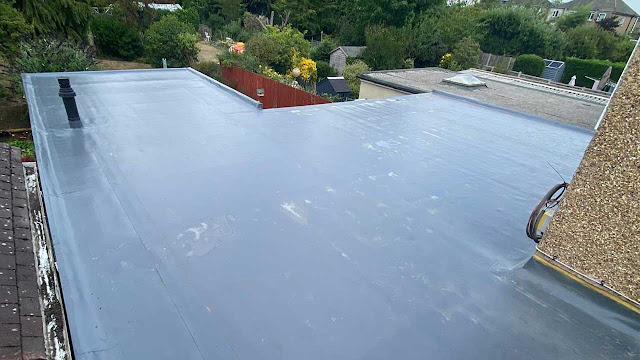Here are top three common flat roof systems that you should consider carefully.
1. Modified Bitumen
Modified bitumen first appeared in commercial roofing in the mid-1960s in Europe. Before that time, the conventional roofing system used on most commercial structures was built-up roofing (BUR), a complicated system of alternating layers of asphalt and fabric with a top layer of gravel.
While BUR was a tried-and-true method, it was heavy, costly to install, difficult to repair, and often had trouble holding up against extreme temperatures.
>> Related Post: Benefits of wood roof for your house.
By integrating the bitumen with polymers and fiberglass into a simple membrane, the developers of modified bitumen hoped to simplify the roofing process while resolving some of the most common issues with BUR.
Overall, the efforts were successful. Modified bitumen proved to be easier to install while providing enhanced protection compared to BUR systems, even in very cold temperatures.
By 1975, modified bitumen was in wide use here in the United States, and today, it has all but replaced BUR as one of the most reliable roofing materials on the market.
As an alternative to plasticizers, which are known to damage the environment, modified bitumen has just been available on the market.
The primary material is then strengthened with various additives, such as polymer and fiberglass, to improve its performance and durability.
>> Related Post: Guide to Requesting Customer Feedback for Swadley Roof Systems.
The two types of modified bitumen that are most frequently used are as follows:
(1) SBS, also known as styrene-butadiene-styrene, which possesses increased flexibility as well as more robust expansion and contraction capabilities,
(2) APP, also known as atactic polypropylene, which possesses increased aging ability. Both of these types of modified bitumen are extremely common.
2. Ethylene Propylene Diene Monomer (EPDM)
Ethylene-Propylene-Diene-Monomer (EPDM) in the roofing world has been a standard practice since its invention by DuPont in the 1950s.
EPDM, a form of synthetic rubber, is a widely used roofing material due to its highly durable, heat-resistant, UV and weather-resistant, and extremely flexible properties.
Technological enhancements to the seams, angle change securement, puncture resistance properties, and flashing details have dramatically improved performance and that EPDM roofs offer, and is the roofing material of choice for numerous architects, contractors, and building owners.
This week, we’re breaking down everything you need to know about EPDM.
EPDM is a kind of rubber in its most basic form. It is constructed out of rubber scraps that have been recycled and then woven together.
If the margins of the EPDM roofing aren't correctly fastened, homeowners who desire EPDM roofing should be aware that it might leak.
>> Related Post: How to Get Started in the Fire, Mold, and Water Restoration Industry and What You'll Need?
Because of this, you need to find residential flat roof contractors near me with expertise and an excellent reputation to have a flat rubber roof installed.
EPDM may be used for a very long time is undoubtedly one of its many advantages. It is possible to live up to 50 years. It is also important to note that EPDM is resistant to water and the elements.
3. Metal
Whether you’re planning for a home renovation or is in the process of building your house, flat roofs are increasingly popular among homeowners and builders.
We’ll let you in on a bit of a secret: this type of roof only works with metal.
That’s because tiles leave small gaps between, which water can get into. This isn’t an issue with sloped roofs, as the roof angle means that the only way for water to get in is if it defies gravity and moves upwards.
In short, it’s close to impossible.
When the roof is flat however, water now has a way in. As we’ve talked about before, this can lead to a host of problems.
Metal roofing, on the other hand comes with no such limitation, as metal roofing panels are joined in a way that effectively makes them watertight.
If you have the funds available, flat metal roofing is an excellent option to think about. It is in the upper price category owing to excellent reasons.
For one, metal roofing is adaptable. There is a selection of various options available to pick from. There's aluminum, steel, zinc, or copper.
>> Related Post: Gzone6, KDHay, Logarid, Camtruyen.
You also have a wide variety of options to choose from for color and finish. In addition to this, they are chemical-free, lightweight, long-lasting, and sturdy contributes to the increased cost of purchasing them, according to residential flat roof contractors near me.
The noise generated by metal roofing may become an issue for those who live in regions prone to experiencing severe storms or rainfall.
However, there is also the fact that it is resistant to fire, making it an excellent choice for residential use.
Conclusion
Swadley Roof Systems offers the best roofing services in the Houston, Austin, San Antonio and Dallas area.
- Tel: 832-559-8463
- Email: info@swadleyroofsystems.com
- Location: 17413 FM 2920 Suite O Tomball, TX 77377
- Facebook: Fanpage Swadley Roof Systems
- Website: https://www.swadleyroofsystems.com/







0 Comments
Đăng nhận xét